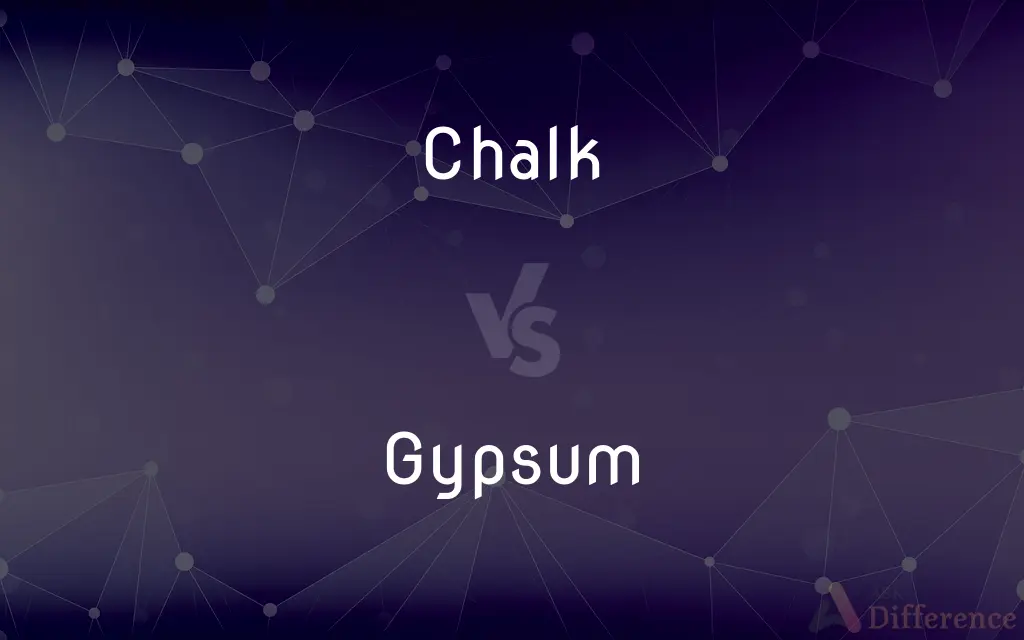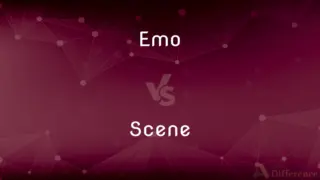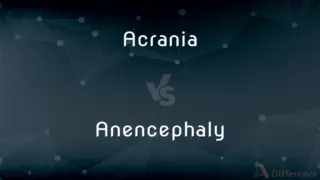Chalk vs. Gypsum — What's the Difference?
Edited by Tayyaba Rehman — By Fiza Rafique — Updated on October 25, 2023
Chalk is a soft, white limestone; Gypsum is a mineral used in building materials and fertilizers. Both are sedimentary but differ in composition and uses.

Difference Between Chalk and Gypsum
Table of Contents
ADVERTISEMENT
Key Differences
Chalk and Gypsum are both naturally occurring substances that are widely used in various applications. Chalk is a soft, white limestone mainly composed of the mineral calcite. It forms under shallow marine conditions from the accumulation of tiny marine organisms' calcium carbonate shells. Gypsum, on the other hand, is a soft sulfate mineral composed of calcium sulfate dihydrate. It is typically found as massive evaporative deposits.
Chalk has been used historically for writing on blackboards and drawing on pavements. It is also used in the production of lime and cement. Gypsum is most commonly known for its application in the manufacture of wallboard or drywall. It's also utilized in making plaster products and even in food items like tofu.
In terms of geographical distribution, Chalk deposits are usually found in regions that were once deep under the sea, such as the white cliffs of Dover in the UK. Gypsum deposits, however, are often located in arid regions where saline water has evaporated, leading to the crystallization of the mineral.
Another distinguishing factor between Chalk and Gypsum is their reaction to hydrochloric acid. When Chalk comes into contact with acid, it fizzes due to the release of carbon dioxide. Gypsum, however, remains unaffected when subjected to acid because it lacks the carbonate component that chalk has.
To sum it up, while both Chalk and Gypsum are valuable resources with a myriad of applications, they differ in composition, origin, location, and reaction to acid. They serve as a testament to the variety and utility of Earth's natural resources.
ADVERTISEMENT
Comparison Chart
Composition
Mainly calcium carbonate
Calcium sulfate dihydrate
Formation
Marine conditions
Evaporative deposits
Uses
Writing, lime, cement
Wallboard, plaster, some food items
Reaction to Acid
Fizzes due to CO2 release
Remains unaffected
Typical Locations
Former deep sea regions
Arid regions with saline water evaporation
Compare with Definitions
Chalk
To rub or cover with chalk, as the tip of a billiard cue.
Gypsum
A protective layer applied to walls or ceilings.
The Gypsum layer protects the underlying wood structure.
Chalk
A soft, white limestone, primarily composed of calcite.
The white cliffs of Dover are made of Chalk.
Gypsum
A soft sulfate mineral consisting of calcium sulfate dihydrate.
The desert contains vast Gypsum deposits.
Chalk
A stick of this limestone or a similar substance used for writing or drawing.
The teacher used red Chalk to underline the important points.
Gypsum
A rock or sediment containing this mineral.
He carved a sculpture out of a piece of Gypsum.
Chalk
Chalk is a soft, white, porous, sedimentary carbonate rock, a form of limestone composed of the mineral calcite and originally formed deep under the sea by the compression of microscopic plankton which had fallen to the sea floor. Chalk is common throughout Western Europe, where deposits underlie parts of France, and steep cliffs are often seen where they meet the sea in places such as the Dover cliffs on the Kent coast of the English Channel.
Gypsum
To apply or treat with gypsum.
To enrich the soil, farmers often Gypsum their fields.
Chalk
A white soft earthy limestone (calcium carbonate) formed from the skeletal remains of sea creatures.
Gypsum
A substance used in making plaster, drywall, and fertilizers.
They mined the Gypsum to produce drywall for construction.
Chalk
Short for French chalk
Gypsum
Gypsum is a soft sulfate mineral composed of calcium sulfate dihydrate, with the chemical formula CaSO4·2H2O. It is widely mined and is used as a fertilizer and as the main constituent in many forms of plaster, blackboard/sidewalk chalk, and drywall. A massive fine-grained white or lightly tinted variety of gypsum, called alabaster, has been used for sculpture by many cultures including Ancient Egypt, Mesopotamia, Ancient Rome, the Byzantine Empire, and the Nottingham alabasters of Medieval England.
Chalk
Write or draw with chalk
He chalked a message on the board
Gypsum
A widespread colorless, white, or yellowish mineral, CaSO4·2H2O, used in the manufacture of plaster of Paris, various plaster products, and fertilizers.
Chalk
Charge (drinks bought in a pub or bar) to a person's account
He chalked the bill on to the Professor's private account
Gypsum
A mineral consisting of hydrated calcium sulphate. When calcinated, it forms plaster of Paris.
Chalk
A soft compact calcite, CaCO3, with varying amounts of silica, quartz, feldspar, or other mineral impurities, generally gray-white or yellow-white and derived chiefly from fossil seashells.
Gypsum
A mineral consisting of the hydrous sulphate of lime (calcium). When calcined, it forms plaster of Paris. Selenite is a transparent, crystalline variety; alabaster, a fine, white, massive variety.
Chalk
A piece of chalk or chalklike substance in crayon form, used for marking on a blackboard or other surface.
Gypsum
A common white or colorless mineral (hydrated calcium sulphate) used to make cements and plasters (especially plaster of Paris)
Chalk
(Games) A small cube of chalk used in rubbing the tip of a billiard or pool cue to increase its friction with the cue ball.
Chalk
A mark made with chalk.
Chalk
Chiefly British A score or tally.
Chalk
To mark, draw, or write with chalk
Chalked my name on the blackboard.
Chalk
To make pale; whiten.
Chalk
To treat (soil, for example) with chalk.
Chalk
(uncountable) A soft, white, powdery limestone (calcium carbonate, CaCO3).
Chalk cliffs are not recommended for climbing
Chalk
(countable) A piece of chalk, or nowadays processed compressed gypsum (calcium sulfate, CaSO4), that is used for drawing and for writing on a blackboard (chalkboard).
The chalk used to write on the blackboard makes a squeaky sound
Chalk
Tailor's chalk.
Chalk
A white powdery substance used to prevent hands slipping from holds when climbing, or losing grip in weight-lifting or gymnastics, sometimes but not always limestone-chalk, often magnesium carbonate (MgCO3).
When working out your next move, it's a good idea to get some more chalk from the bag
Chalk
A platoon-sized group of airborne soldiers.
Chalk
The favorite in a sporting event.
Chalk
The prediction that there will be no upsets, and the favored competitor will win.
Chalk
To apply chalk to anything, such as the tip of a billiard cue.
Chalk your hands before climbing
Chalk
To record something, as on a blackboard, using chalk.
Chalk
To use powdered chalk to mark the lines on a playing field.
Chalk
(figuratively) To record a score or event, as if on a chalkboard.
Chalk
To manure (land) with chalk.
Chalk
To make white, as if with chalk; to make pale; to bleach.
Chalk
A soft, earthy substance, of a white, grayish, or yellowish white color, consisting of calcium carbonate, and having the same composition as common limestone.
Chalk
Finely prepared chalk, used as a drawing implement; also, by extension, a compound, as of clay and black lead, or the like, used in the same manner. See Crayon.
Chalk
To rub or mark with chalk.
Chalk
To manure with chalk, as land.
Chalk
To make white, as with chalk; to make pale; to bleach.
Let a bleak paleness chalk the door.
Chalk
A soft whitish calcite
Chalk
A pure flat white with little reflectance
Chalk
Amphetamine used in the form of a crystalline hydrochloride; used as a stimulant to the nervous system and as an appetite suppressant
Chalk
A piece of chalk (or similar substance) used for writing on blackboards or other surfaces
Chalk
Write, draw, or trace with chalk
Chalk
A mark made using this substance.
The Chalk lines on the field indicate the boundaries.
Chalk
A cue tip's substance in billiards and pool.
Before his shot, he applied Chalk to his cue stick.
Chalk
To draw or write with chalk.
He Chalked a message on the blackboard.
Common Curiosities
How is Gypsum typically used in construction?
Gypsum is used to make wallboard or drywall.
Is Gypsum edible?
While the mineral itself isn't typically consumed, it's used in food processing, like in tofu production.
How does Gypsum react to acid?
Gypsum remains unaffected when exposed to acid.
Can Chalk be used for drawing?
Yes, Chalk can be used for drawing on surfaces like pavements.
Can Chalk be used in cement production?
Yes, Chalk is used in the production of lime and cement.
Are both Chalk and Gypsum soft minerals?
Yes, both Chalk and Gypsum are soft and can be easily scratched.
Is Chalk soluble in water?
Chalk is not very soluble in water.
What is Chalk primarily composed of?
Chalk is primarily composed of calcium carbonate.
What color is typical for Gypsum?
Gypsum can range from white to gray and can even be transparent.
Where can large deposits of Chalk be found?
Chalk deposits are found in regions that were once under the sea, like the white cliffs of Dover.
How does Chalk react to acid?
Chalk fizzes when it contacts acid due to carbon dioxide release.
How does Gypsum form naturally?
Gypsum forms from the evaporation of saline water, leading to its crystallization.
What color is typical for Chalk?
Chalk is typically white.
Is Gypsum used in agriculture?
Yes, Gypsum can be applied to soils to improve their texture and drainage.
Is Gypsum soluble in water?
Gypsum has low solubility in water but can dissolve over time.
Share Your Discovery

Previous Comparison
Emo vs. Scene
Next Comparison
Acrania vs. AnencephalyAuthor Spotlight
Written by
Fiza RafiqueFiza Rafique is a skilled content writer at AskDifference.com, where she meticulously refines and enhances written pieces. Drawing from her vast editorial expertise, Fiza ensures clarity, accuracy, and precision in every article. Passionate about language, she continually seeks to elevate the quality of content for readers worldwide.
Edited by
Tayyaba RehmanTayyaba Rehman is a distinguished writer, currently serving as a primary contributor to askdifference.com. As a researcher in semantics and etymology, Tayyaba's passion for the complexity of languages and their distinctions has found a perfect home on the platform. Tayyaba delves into the intricacies of language, distinguishing between commonly confused words and phrases, thereby providing clarity for readers worldwide.
















































